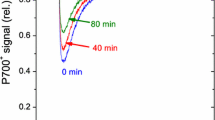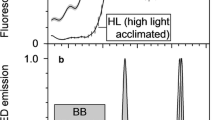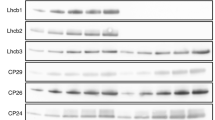Abstract
Complementary techniques of chlorophyll a fluorescence, steady state CO2 exchange, and O2 release during a multiple turnover flash were applied to compare responses to irradiance for leaves of wild type and psbS mutants. The latter included variants in which the psbS gene was deleted (npq4-1) or possessed a single point mutation (npq4-9). Nonphotochemical quenching (NPQ) was reduced by up to 80 and 50%, respectively, in these lines at high irradiance. Analysis of changes in steady-state fluorescence yields and quantum yield of linear electron transport in the context of the reversible radical pair model of Photosystem II (PS II) indicated that NPQ occurs by nonradiative deactivation of chlorophyll singlet states in normal leaves. In contrast, application of the same criteria together with the observed irreversibility of NPQ and decline in density of functional PS II reaction centers following excessive illumination indicated a change in reaction center properties for the psbS deletion phenotype (Npq4-1−). Specifically, PS II reaction centers in Npq4-1− convert to a photochemically inactive, yet strongly quenching, form in intense light. The possibility of formation of a carotenoid or chlorophyll cation quencher in the reaction center is discussed. Results for the point mutant phenotype (Npq4-9−) were intermediate to those of wild-type and Npq4-1−. Furthermore, wild-type leaves exhibited a significant reversible increase in the PS II in vivo rate constant for photochemistry (kP0) in saturating compared to limiting light. Changes in kP0 could not be accounted for in terms of a classic phosphorylation-dependent (state transition) mechanism. Changes in kP0 may arise from alternate pigment—protein conformations that alter the way excitons equilibrate among PS II chromophores. The lack of similar irradiance-dependent changes in kP0 for the psbS mutants suggests a role for the PS II-S protein in the regulation of exciton distribution.
Similar content being viewed by others
References
Allen JF (1992) Protein phosphorylation in regulation of photosynthesis. Biochim Biophys Acta 1098: 275–335
Barter LMC, Bianchietti M, Jeans C, Schilstra MJ, Hankamer B, Diner BA, Barber J, Durrant JR and Klug DR (2001) Relationship between excitation energy transfer, trapping, and antenna size in Photosystem II. Biochemistry 40: 4026–4034
Bilger W and Björkman O (1990) Role of the xanthophyll cycle in photoprotection elucidated by measurements of light-induced absorbance changes, fluorescence and photosynthesis in leaves of Hedera canariensis. Photosynth Res 25: 173–185
Blubaugh DJ, Atamian M, Babcock GT, Golbeck JH and Cheniae GM (1991) Photoinhibition of hydroxylamine-extracted Photosystem II membranes: identification of the sites of photodamage. Biochemistry 30: 7586–7597
Boekema EJ, van Breemen JFL, van Roon H and Dekker JP (2000) Conformational changes in Photosystem II supercomplexes upon removal of extrinsic subunits. Biochemistry 39: 12907–12915
Crofts J and Horton P (1991) Dissipation of excitation energy by Photosystem II particles at low pH. Biochim Biophys Acta 1058: 187–193
Dau H (1994) Molecular mechanisms and quantitative models of variable Photosystem II fluorescence. Photochem Photobiol 60: 1–23
Demmig B, Winter K, Krüger A and Czygan F-C (1987) Photoinhibition and zeaxanthin formation in intact leaves: a possible role of the xanthophyll cycle in the dissipation of excess light. Plant Physiol 84: 218–224
Funk C, Schröder WP, Napiwotzki A, Tjus SE, Renger G and Andersson B (1995) The PS II-S protein of higher plants: a new type of pigment-binding protein. Biochemistry 34: 11133–11141
Genty B, Briantais J-M and Baker NR (1989) The relationship between the quantum yield of photosynthetic electron transport and quenching of chlorophyll fluorescence. Biochim Biophys Acta 990: 87–92
Genty B, Harbinson J, Briantais J-M and Baker NR (1990) The relationship between non-photochemical quenching of chlorophyll fluorescence and the rate of Photosystem 2 photochemistry in leaves. Photosynth Res 25: 249–257
Genty B, Wonders J and Baker NR (1990) Non-photochemical quenching of Fo in leaves is emission wavelength dependent: consequences for quenching analysis and its interpretation. Photosynth Res 26: 133–139
Gilmore AM and Yamamoto HY (1993) Linear models relating xanthophylls and lumen acidity to non-photochemical fluorescence quenching. Evidence that antheraxanthin explains zeaxanthin independent quenching. Photosynth Res 35: 67–78
Gilmore AM, Itoh S and Govindjee (2000) Global spectral-kinetic analysis of room temperature chlorophyll a fluorescence from light-harvesting antenna mutants of barley. Phil Trans R Soc London Ser B Biol Sci 355: 1371–1384
Haldrup A, Jensen PE, Lunde C and Scheller HV (2001) Balance of power: a view of the mechanism of photosynthetic state transitions. Trends Plant Sci 6: 301–305
Horton P, Ruban AV and Walters RG (1996) Regulation of light harvesting in green plants. Annu Rev Plant Physiol Plant Mol Biol 47: 655–684
Külheim C, Ågren J and Jansson S (2002) Rapid regulation of light harvesting and plant fitness in the field. Science 297: 91–93
Laisk A and Loreto F (1996) Determining photosynthetic parameters from leaf CO2 exchange and chlorophyll fluorescence: Rubisco specificity factor, dark respiration in the light, excitation distribution between photosystems, alternative electron transport and mesophyll diffusion resistance. Plant Physiol 110: 903–912
Laisk A and Oja V (1998) Dynamics of Leaf Photosynthesis. Rapid Response Measurements and Their Interpretations. CSIRO, Collingwood, Australia
Laisk A and Oja V (2000) Alteration of Photosystem II properties with non-photochemical excitation quenching. Phil Trans R Soc London Ser B Biol Sci 355: 1405–1418
Laisk A, Oja V, Rasulov B, Eichelmann H and Sumberg A (1997) Quantum yields and rate constants of photochemical and nonphotochemical excitation quenching. Experiment and model. Plant Physiol 115: 803–815
Lavergne J and Trissl H-W (1995) Theory of fluorescence induction in Photosystem II: derivation of analytical expressions in a model including exciton-radical-pair equilibrium and restricted energy transfer between photosynthetic units. Biophys J 68: 2474–2492
Li X-P, Björkman O, Shih C, Grossman AR, Rosenquist M, Jansson S and Niyogi KK (2000) A pigment-binding protein essential for regulation of photosynthetic light harvesting. Nature 403: 391–395
Nield J, Funk C and Barber J (2000) Supermolecular structure of Photosystem II and location of the PsbS protein. Phil Trans R Soc London Ser B Biol Sci 355: 1337–1343
Niyogi KK (1999) Photoprotection revisited: genetic and molecular approaches. Annu Rev Plant Physiol Plant Mol Biol 50: 333–359
Peterson RB and Havir EA (2000) A nonphotochemical quenchingdeficient mutant of Arabidopsis thaliana possessing normal pigment composition and xanthophyll cycle activity. Planta 210: 205–214
Peterson RB and Havir EA (2001) Photosynthetic properties of an Arabidopsis thaliana mutant possessing a defective psbS gene. Planta 214: 142–152
Peterson RB, Oja V and Laisk A (2001) Chlorophyll fluorescence at 680 and 730 nm and leaf photosynthesis. Photosynth Res 70: 185–196
Schatz GH, Brock H and Holzwarth AR (1988) Kinetic and energetic model for the primary processes of Photosystem II. Biophys J 54: 397–405
Schweitzer RH, Melkozernov AN, Blankenship RE and Brudvig GW (1998) Time-resolved fluorescence measurements of Photosystem II: the effect of quenching by oxidized chlorophyll Z. J Phys Chem B 42: 8320–8326
Siefermann D and Yamamoto HY (1975) Properties of NADPH and oxygen-dependent zeaxanthin epoxidation in isolated chloroplasts. A transmembrane model for the violaxanthin cycle. Arch Biochem Biophys 171: 70–77
Stewart DH and Brudvig GW(1998) Cytochrome b559 of Photosystem II. Biochim Biophys Acta 1367: 63–87
Thompson LK and Brudvig GW (1988) Cytochrome b559 may function to protect Photosystem II from photoinhibition. Biochemistry 27: 6653–6658
Vasil'ev S, Orth P, Zouni A, Owens TG and Bruce D (2001) Excitedstate dynamics in Photosystem II: Insights from the X-ray crystal structure. Proc Natl Acad Sci USA 98: 8602–8607
Walters RG and Horton P (1999) Structural and functional heterogeneity in the major light-harvesting complexes of higher plants. Photosynth Res 61: 77–89
Author information
Authors and Affiliations
Corresponding author
Rights and permissions
About this article
Cite this article
Peterson, R.B., Havir, E.A. Contrasting modes of regulation of PS II light utilization with changing irradiance in normal and psbS mutant leaves of Arabidopsis thaliana . Photosynthesis Research 75, 57–70 (2003). https://doi.org/10.1023/A:1022458719949
Issue Date:
DOI: https://doi.org/10.1023/A:1022458719949




